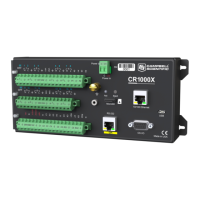3. Setting up the data logger
The basic steps for setting up your data logger to take measurements and store data are included
in the following sections:
l Setting up communications with the data logger (p. 16)
l Virtual Ethernet over USB (RNDIS) (p. 18)
l Ethernet communications option (p. 19)
l Testing communications and connecting (p. 22)
l Data logger program (p. 23)
3.1 Setting up communications with the
data logger
The first step in setting up and communicating with your data logger is to configure your
connection. Communications peripherals, data loggers, and software must all be configured for
communications. Additional information is found in your specific peripheral manual, and the
data logger support software manual and help.
The default settings for the data logger allow it to communicate with a computer via USB, RS-
232, or Ethernet. For other communications methods or more complex applications, some
settings may need adjustment. Settings can be changed through Device Configuration Utility or
through data logger support software.
3.1.1 Communications options
You can configure your connection using any of the following options. The simplest is via USB.
For detailed instruction, see:
l USB or RS-232 communications (p. 17)
l Virtual Ethernet over USB (RNDIS) (p. 18)
l Ethernet communications option (p. 19)
For other configurations, see the LoggerNet EZSetup Wizard help. Context-specific help is given
in each step of the wizard by clicking the Help button in the bottom right corner of the window.
For complex data logger networks, use Network Planner.
3. Setting up the data logger 16

